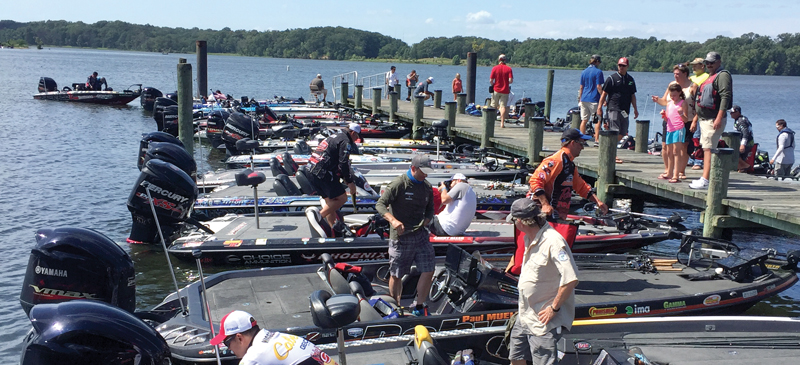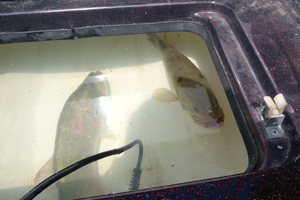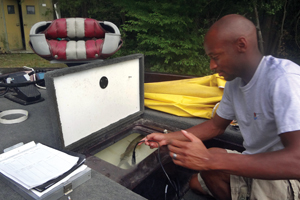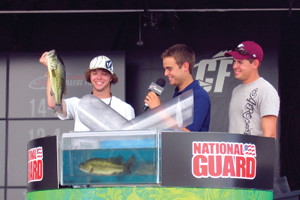Competition and Conservation: Bass tournaments popularize a fishery

Anglers preparing for tournament; all photos by Joe Love
Black bass fishing is synonymous with both largemouth and smallmouth bass. Its popularity in the late 20th century exploded into a multimillion dollar competitive sport, spawning professional fishing tournaments not just here in Maryland, but around the world.
In the beginning, these competitive events led to many dead fish. That is, until Bass Anglers Sportsman Society founder Ray Scott championed the spirit of black bass conservation. These efforts have helped guide the evolution of tournament organization over the past 50 years.

Oxygen measurement
The tools to conserve
The methods underpinning competitive sport fishing have diversified over time. New and evolving technologies—such as oxygen infusers for live wells and culling bags—reduce fish stress and improve health. Throughout that evolution, anglers have invested in both a competitive edge and conservation practices that help keep bass alive.
Today, the appearance of common sport fishing tournaments tends to be similar, no matter where they occur: a bass is caught, landed and added to a small tank on the boat called a livewell. The way a livewell works is pretty simple. It pumps fresh water from a river or lake into an angler’s boat, where catches can be safely stored for upward of eight hours. Keeping fish alive on tournament day isn’t easy, but thanks to time and investments being pumped into conservation efforts, it’s estimated that more than 95 percent of caught bass during a tournament can be released alive.
Weighing options
In spite of conservation successes, tournament directors and anglers have identified other problems with their sport. Achieving conservation standards can be complicated and expensive during challenging summer months. As a service to directors, the Maryland Department of Natural Resources distributes educational information.
In 2012, a consortium of professional anglers created Major League Fishing. This new association came to the sport with an entirely different approach. Instead of relying on the daily weigh-in used by traditional tournaments, this league’s method favored anglers immediately weighing and releasing their catches.

Biologist measuring oxygen
Not only does this approach serve as a measure for black bass conservation, but it also changed tournament procedures. Incorporating real-time weights enables anglers and fans to track their progress throughout the day rather than just at the final weigh-in. This style caught the attention of club tournaments in Maryland, including Fish On Bass, which has already conducted two on-the-water weigh-in tournaments.
Using a calibrated hand scale, anglers on the boat must agree to the final registered weight before recording it. After it’s weighed, the fish is released. Club President Gary Synder said, “A few anglers still enjoy the idea of walking fish across the stage, but most have found a lot of practical benefits with on-the-water weigh-ins.”
Some of the benefits Synder alludes to range from the reduction of stress on caught fish to financial incentive. In particular, anglers have saved money on additives for livewells. As for the total transitioning cost for an on-the-water weigh-in? Clubs with about 20 boats look at about $700.
Crowdsourcing judges
Other groups, like the Susquehanna River Fishing Club are utilizing social media users as their official judges. Reporting a catch online isn’t too new, and several apps are available for download, like Chesapeake Catch, which helps anglers record their fishing experiences.
The rise of social media has more effectively inspired the growth of a new branch of competitive sport fishing that significantly improves the survival odds, in addition to growing its fan base.
President Don Goff helped to pioneer a new aspect of black bass tournament in the tidewaters of the Upper Chesapeake Bay. His inspiration stemmed from not just the rapid growth of internet users over the past two decades, but the large number of users who invest time in social media platforms like Facebook and Twitter.
In 2014, this savvy outdoorsman wanted to start a fishing club. Without money, he turned to online platforms and developed what he calls catch-photo-release tournaments. These events target anglers who may not have bass boats or livewells. In fact, Goff fell into this category himself and uses his kayak as his primary fishing boat.

Weigh-in during college series tournament
Anglers who enter these tournaments report their catches with photos. Because the anglers do not have a hand scale, they use different quantifiers to determine a winner. For example, an angler who catches the most fish or the longest fish may win the day.
The catches are submitted throughout the day to a panel of judges, who may in fact include all of the tournament participants. They then decide whether the bass should be counted toward the anglers’ creel.
Goff added that bass fishing is a growing sport, and despite it being in its infancy, there is an opportunity for catch-photo-release tournaments or other uses of technology to evolve in this area. Certainly, these tools can offer anglers what campfires offer campers: an opportunity to witness a bass weight and share fishing stories with others.
Growing the fishery
In Maryland, it is illegal to possess black bass in non-tidal water March 1-June 15, which is when the species reproduces. On-the-water weigh-in tournaments allow anglers an opportunity to have a tournament during such periods. For management agencies, on-the-water weigh-ins also provide better estimates of how many fish are caught per day.
With conservation and expansion top of mind, some may question if on-the-water weigh-ins and catch-photo-release tournaments are part of the future of competitive sport fishing. One thing’s certain: these methods not only help maintain the fishery, but also entice new audiences. In effect, the future for black bass fisheries has indeed gotten a bit brighter.
Article by Joe Love, Ph.D.—Fishing and Boating Services tidal bass program manager. Appears in Vol. 21, No. 2 of the Maryland Natural Resource magazine, spring 2018.


 1-888-373-7888
1-888-373-7888 233733
233733